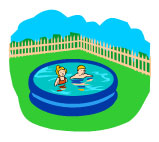In chemistry, the densities of objects are often compared to the density of water. What is the density of water? Complete this online lab to determine the density of water.
![]() Copy the following data table onto your paper.
Copy the following data table onto your paper.
Mass (g) |
Volume (mL) |
Density (g/mL) |
|||
Full Container |
Empty Container |
Water |
|||
| Container 1 | |||||
| Container 2 | |||||
| Container 3 | |||||
Answer the following questions on your own paper.
Interactive popup. Assistance may be required.
The density of water is 1.0 g/cm3.

Interactive popup. Assistance may be required.
The density of the water in the pool would be around 1.0 g/cm3. The density of water is always 1.0 g/cm3. However, there might be some chemicals in the pool water that might change the density slightly.
Interactive popup. Assistance may be required.
A size independent property is not affected by the amount of substance present. In this activity, there were three different volumes and masses of water. The density in each sample of water was 1.0g.
If an object has a density greater than 1.0 g/cm3, and the object is placed in water, it will sink. If the object's density is less than 1.0 g/cm3, and the object is placed in water, the object will float.
Analyze the data table below. Determine if the material will sink or float when placed in water. Click on the blanks to check your answers.
Material |
Density (g/cm3) |
Sink or Float |
| Charcoal | .2 |
Interactive button. Assistance may be required. |
| Iron | 7.8 |
Interactive button. Assistance may be required. |
| Wood | .53 |
Interactive button. Assistance may be required. |
| Brick | 2.4 |
Interactive button. Assistance may be required. |
| Paraffin Wax | .72 |
Interactive button. Assistance may be required. |
| Nickel | 8.8 |
Interactive button. Assistance may be required. |
| Cork | .24 |
Interactive button. Assistance may be required. |